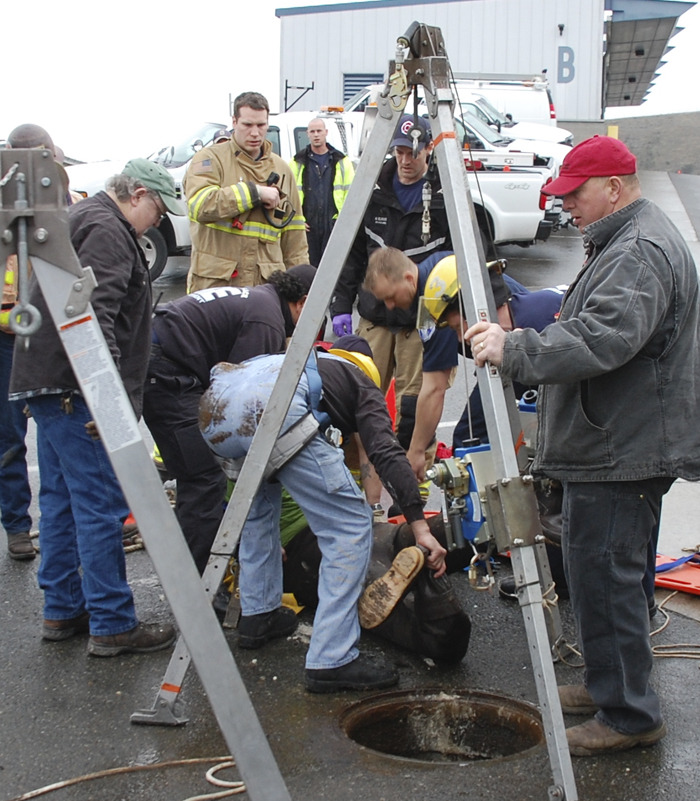When a contract worker was accidentally swept into a sewer tunnel on March 21, training in confined space entry kicked in for more than 30 Chambers Creek Regional Wastewater Treatment Plant workers, according to Pierce County officials who recapped the rescue plan this morning.
Members from the maintenance and operations sections worked together as a single, well-practiced team, according to collection system manager Larry Butner. “There was no time for coordination or a central leader,” said Butner. “Each person saw something that needed doing and they did it. Everybody knew what to do.”
As soon as he heard about the incident, county inspector Bob Buckley called maintenance program manager Scott Roth at the treatment plant, notifying him that the man was swept into the tunnel at a location just over a half mile away. Roth immediately used his two-way radio to alert everyone at the plant that an emergency confined space entry maneuver with harnesses with lifelines was needed.
There are only three sewer tunnel access points at the treatment plant before it terminates at the headworks of the plant in a series of step screens. Butner grabbed his high-powered flashlight and a chain hoist and ran to the most upstream point, the energy dissipater. It is pitch-black inside the pipe and his light would help the man see.
Meanwhile, the others set up hoists and formed two-man entry teams at the next two downstream points. Mark Newport lowered Bob Atkinson into Manhole 6200 and Roth lowered John Dusek into Portal #1 in hopes of intercepting the man as he slid through the pipe.
They didn’t know exactly where he was. By following the sound of his voice, they knew he had passed the energy dissipater and was on his way to the headworks. They waited for what seemed like forever at the next opening, MH 6200, hoping to snag him and hook him to a lifeline.
Treatment plant staff often speculate whether anyone could survive such a fall and journey inside the pipe. In October, 2010 a Missouri man was in critical condition after being swept more than a mile through a 27-inch sewer system pipe.
At Chambers Creek, the pipe is 72 inches in diameter at the point where the man fell in and 48 inches at MH 6200, increasing the likelihood of his survival. Still, workers resigned themselves to the possibility that this could become a victim recovery effort rather than a live rescue, a conclusion also shared by the arriving fire department personnel.
As they peered down the hole, a hand finally reached out from the wastewater flow and grabbed the rope. Then the man emerged from the pipe and stood up while grabbing the manhole ladder; he was very much alive. Under the direction of confined entry supervisor Newport and West Pierce Fire and Rescue incident commander Kevin Kroenert, they hooked onto his harness and hoisted him out of the hole in a matter of seconds. Cheers erupted as the man was rescued.
The man’s waders were filled with wastewater from the pipe, but despite the contamination and stench, fire fighters and paramedics wasted no time removing his gear and preparing him for transport to the hospital.
In Kroenert’s opinion, the man could not have held on much longer. The force of the current had weakened him considerably and his hand slipped from the ladder the second after the lifeline was attached. “This man wouldn’t be alive today if it weren’t for your people,” Kroenert told county utility managers. “I credit them for saving his life, and it was great working with people who didn’t lose their cool and are well-versed in their training.” Kroenert also expressed that the man is lucky his neck wasn’t broken when his hard hat caught on a grate and was torn off his head as he swept through the pipe. The hard hat was later recovered at the step screens.
The man’s descent through the tunnel could have been stopped at an illuminated man-catcher at Portal #2. It was installed to stop anyone that accidentally entered the tunnel. But as the man reached to hook on with his safety latch, a surge of water swept over his head and face, obstructing his vision and airway. The surge pushed him down into the pipe and beyond the emergency exit shaft.
The total elapsed time from fall to rescue was about 30 minutes. It was only 14 minutes from the radio call for action to the successful conclusion, but to rescuers it seemed like an eternity. Photos and video captured the situation as it unfolded, thanks to quick thinking by George Molinaro, Terry Soden, and Larry Ekstrom.
All treatment plant employees are required to pass confined space entry and fall protection training, with mandatory participation in annual manhole and confined space drills. Everyone trains in the role of the rescuer as well as the person being rescued.
Wastewater Utility manager Tim Ramsaur praised the team before the Pierce County Council afterward. “They followed their training and made a fabulous effort,” he said. “The fallen man’s training also served him well, helping him remain calm. It was a great job and I applaud staff.” He noted that improvements to the treatment plant headworks in recent years undoubtedly contributed to the man’s survival.
Kroenert also expressed high praise for treatment plant workers for their speed and competency during the rescue operation. “Fire and Rescue couldn’t have done it any faster,” he said.
Pierce County contractor rescued after 3,500-foot slide through sewage system (03/21/11) – http://www.tacomadailyindex.com/portals-code/list.cgi?paper=88&cat=23&id=1944709&more=0





